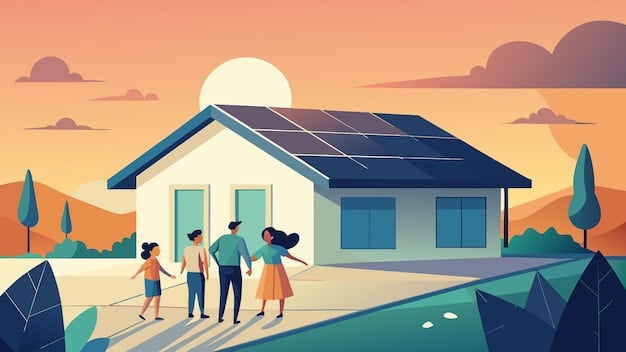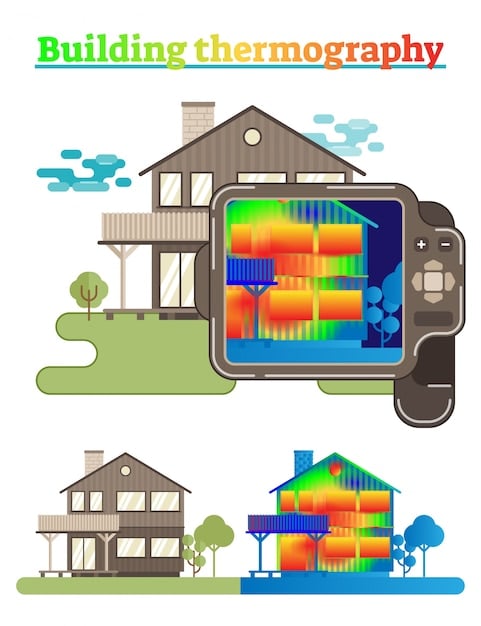Solar Power for Beginners: Save 60% on Energy with Panels

Solar Power for Beginners: A Guide to Installing Solar Panels and Saving Up to 60% on Energy Costs outlines the essential steps and benefits for homeowners looking to transition to solar energy, emphasizing significant savings and environmental advantages through a practical, step-by-step approach.
Embarking on the journey of harnessing the sun’s power can seem daunting, but with the right guidance, it’s a rewarding step towards energy independence and significant savings. This comprehensive guide, “Solar Power for Beginners: A Guide to Installing Solar Panels and Saving Up to 60% on Energy Costs,” offers a clear, step-by-step pathway for homeowners in the US to embrace renewable energy, transforming their properties into efficient, cost-saving powerhouses.
Understanding Solar Energy: The Basics and Beyond
The concept of solar energy revolves around converting sunlight into electricity, a process fundamental to understanding how solar panels work. This transformation occurs through photovoltaic (PV) cells, which are the core components of solar panels. When sunlight strikes these cells, it excites electrons, generating an electric current. This direct current (DC) electricity is then converted into alternating current (AC) by an inverter, making it suitable for use in homes and businesses.
Beyond the basic science, appreciating the broader impact of solar energy is crucial. It represents a shift from traditional fossil fuels to a clean, abundant, and renewable resource. This transition offers not only environmental benefits by reducing carbon emissions but also economic advantages, particularly for homeowners looking to minimize their monthly expenses.
The Science Behind the Savings
The efficiency of solar panels plays a significant role in how much energy you can generate and, consequently, how much you can save. Modern solar panels have improved considerably in efficiency, typically converting 15-20% of sunlight into usable electricity. Factors like panel quality, installation angle, and local weather patterns influence this output.
When your solar system produces more electricity than you consume, the excess can often be sent back to the grid through a program called net metering. This allows you to earn credits or even cash for the surplus energy, further enhancing your savings. Understanding these mechanisms is key to maximizing your investment.
- Photovoltaic Effect: How sunlight directly generates electricity.
- Inverter Technology: Converting DC to AC for household use.
- Net Metering Programs: Earning credits for excess energy fed back to the grid.
- Efficiency Ratings: Understanding how panel efficiency impacts energy output.
In essence, adopting solar power is about leveraging natural resources to create a sustainable and economically sound energy solution for your home. The technology is robust, and the financial incentives are increasingly attractive, making it a viable option for many.
Evaluating Your Home’s Solar Potential: Is Your Home Ready?
Before diving into installation, assessing your home’s suitability for solar panels is a critical first step. Not every roof is ideal, and several factors can influence the efficiency and return on investment of a solar system. This evaluation typically involves looking at roof characteristics, sun exposure, and current energy consumption patterns.
Professional solar installers often conduct a site assessment to determine these factors. They will examine your roof’s age, structural integrity, and shading issues. A well-performing solar system requires ample, unobstructed sunlight throughout the day. Even partial shading can significantly reduce energy production.
Key Assessment Factors
Several elements contribute to a successful solar installation. The orientation of your roof, ideally facing south in the Northern Hemisphere, is paramount. The pitch of the roof also matters, with angles between 30 and 45 degrees generally being optimal for capturing sunlight.
Another crucial aspect is your historical energy usage. Reviewing your electricity bills from the past year can give you a clear picture of your consumption habits. This data helps in sizing the solar system correctly, ensuring it meets your energy needs or even exceeds them for maximum savings.
- Roof Orientation and Pitch: Optimal angles for sun exposure.
- Shading Analysis: Identifying potential obstructions from trees or buildings.
- Roof Condition: Ensuring the roof can support the panels and won’t need replacement soon.
- Energy Consumption Profile: Analyzing past utility bills to size the system.
Thoroughly evaluating these aspects ensures you make an informed decision and invest in a solar system that delivers optimal performance and cost savings. It’s about planning smartly for a sustainable future.

Choosing the Right Solar Panels and System Type
Selecting the appropriate solar panels and system type is a pivotal decision that influences both efficiency and cost. The market offers a variety of panel types, each with distinct characteristics regarding performance, aesthetics, and price point. Understanding these differences can help you make an informed choice that aligns with your energy goals and budget.
Monocrystalline and polycrystalline panels are the two most common types. Monocrystalline panels, typically darker in color, are known for their higher efficiency and sleeker appearance, making them a popular choice for homeowners with limited roof space. Polycrystalline panels, on the other hand, are generally more affordable and perform well, though with slightly lower efficiency.
System Types: Grid-Tied vs. Off-Grid
Residential solar systems primarily fall into two categories: grid-tied and off-grid. Grid-tied systems are connected to the local utility grid, allowing you to draw power when your panels aren’t producing enough and send excess power back. This is the most common type for homeowners, offering reliability and the benefits of net metering.
Off-grid systems are entirely independent of the utility grid, relying on battery storage to power the home when the sun isn’t shining. While offering complete energy independence, these systems are more complex and expensive due to the significant battery bank required. They are typically chosen for remote locations where grid access is impractical or costly.
- Monocrystalline Panels: High efficiency, space-efficient, good aesthetics.
- Polycrystalline Panels: Cost-effective, good performance, slightly lower efficiency.
- Grid-Tied Systems: Connected to utility grid, net metering benefits, reliability.
- Off-Grid Systems: Energy independence, battery storage required, higher upfront cost.
Choosing the right combination of panel type and system design requires careful consideration of your energy needs, budget, and desired level of independence from the grid. Consulting with experienced solar professionals can guide you through this complex decision-making process.
Navigating Incentives and Financing Options
One of the most appealing aspects of going solar in the US is the availability of various incentives and flexible financing options. These programs are designed to reduce the upfront cost of solar installations, making renewable energy more accessible and affordable for homeowners. Understanding what’s available can significantly impact your return on investment.
The federal solar tax credit, officially known as the Investment Tax Credit (ITC), is arguably the most significant incentive. It allows homeowners to deduct a percentage of the cost of their solar installation from their federal taxes. This credit has been a major driver of solar adoption across the country.
State and Local Programs
Beyond the federal ITC, many states and local municipalities offer their own incentives. These can include state tax credits, rebates, property tax exemptions, and sales tax exemptions. Some regions also have specific programs, such as Solar Renewable Energy Credits (SRECs), where you can earn credits for the renewable energy your system generates.
Financing solar panels has also become more diverse. Options include direct purchase (cash), solar loans, power purchase agreements (PPAs), and solar leases. Each option has its pros and cons regarding upfront cost, ownership, and long-term savings. Solar loans, for instance, allow you to own the system while spreading the cost over time, often resulting in monthly payments lower than your previous electricity bills.
- Federal Investment Tax Credit (ITC): Significant percentage deduction from federal taxes.
- State & Local Incentives: Tax credits, rebates, property and sales tax exemptions.
- Solar Loans: Ownership with manageable monthly payments.
- Power Purchase Agreements (PPAs) / Leases: Lower upfront cost, but you don’t own the system.
Exploring all available incentives and understanding the different financing models is crucial for making solar power financially viable for your home. These programs often make the switch to solar much more affordable than many homeowners initially realize.
The Solar Installation Process: Step-by-Step Guide
Once you’ve assessed your home’s potential, chosen your system, and secured financing, the next phase is the actual installation. While the thought of a home improvement project of this scale might seem daunting, professional solar installation companies streamline the process, guiding you through each step. Knowing what to expect can help ease any concerns.
The journey typically begins with a detailed site inspection by the installer to confirm technical specifications and finalize the system design. This ensures the panels are optimally placed for maximum sun exposure and that your electrical system can handle the new power generation.
From Design to Activation
Following the design approval, permits are the next hurdle. Solar installations require permits from local authorities to ensure compliance with building and electrical codes. Reputable installers handle all the necessary paperwork, navigating the sometimes complex regulatory landscape on your behalf.
The physical installation on your roof usually takes only a few days, depending on the system’s size and complexity. This involves mounting the racking system, securing the panels, and connecting the electrical wiring to the inverter and your home’s main electrical panel. Once installed, the system undergoes final inspections by local authorities and the utility company before it can be connected to the grid and activated. This final connection marks the beginning of your solar energy production and savings.
- Site Assessment & Design: Detailed planning for optimal placement and efficiency.
- Permitting & Approvals: Handling local and utility company regulations.
- Physical Installation: Mounting panels, wiring, and inverter setup.
- Inspection & Activation: Final checks and grid connection for power generation.
The entire process, from initial consultation to system activation, can take several weeks to a few months, largely depending on permitting timelines. Patience during this phase is key, as the end result is a significant investment in a cleaner, more economical future.

Maintaining Your Solar System and Maximizing Savings
Installing solar panels is a fantastic investment, but like any asset, it requires some attention to ensure it performs optimally and delivers the promised savings. Fortunately, solar panel systems are remarkably durable and require relatively low maintenance compared to other home systems. Understanding how to care for your panels can prolong their lifespan and maximize their energy output.
One of the primary maintenance tasks is keeping the panels clean. Dust, dirt, leaves, and bird droppings can accumulate on the panel surface, blocking sunlight and reducing efficiency. In most regions, rainfall is often sufficient to keep panels clean. However, in drier areas or during prolonged dry spells, a simple rinse with a garden hose can be beneficial. Avoid harsh chemicals or abrasive materials that could damage the panels.
Monitoring Performance and Troubleshooting
Modern solar systems typically come with monitoring capabilities, allowing you to track your energy production in real-time. This can be done via online portals or mobile apps provided by your installer or inverter manufacturer. Regularly checking your system’s performance helps you identify any anomalies, such as a drop in production, which might indicate an issue.
While solar panels are built to last, issues can occasionally arise. These might include inverter malfunctions, wiring problems, or damage from severe weather. Most reputable installers offer warranties that cover equipment and workmanship for many years. It is advisable to schedule periodic professional inspections (e.g., every 3-5 years) to ensure all components are functioning correctly and to address any potential issues proactively.
- Routine Cleaning: Rinsing panels to remove accumulated dirt and debris.
- Performance Monitoring: Utilizing apps and portals to track energy output.
- Professional Inspections: Scheduled checks to ensure system health and longevity.
- Warranty Awareness: Understanding coverage for equipment and installation.
By adhering to a simple maintenance routine and staying aware of your system’s performance, you can ensure your solar panels continue to generate substantial savings and contribute to a sustainable future for decades to come, reaping the full benefits of your investment.
| Key Aspect | Brief Description |
|---|---|
| ☀️ Solar Basics | Sunlight converted to electricity via PV cells; reduces carbon footprint. |
| 🏠 Home Readiness | Assess roof, sun exposure, and energy use for optimal installation. |
| 💸 Incentives | Utilize federal tax credits and state programs for significant savings. |
| 🛠️ Installation & Care | Professional setup, regular cleaning, and monitoring for peak performance. |
Frequently Asked Questions About Solar Power
▼
Savings vary based on your energy consumption, system size, and local utility rates. However, many homeowners report saving between 30% to 60% on their electricity bills annually. Over the lifespan of the system, this can amount to tens of thousands of dollars, effectively paying for the initial investment and significantly reducing your overall energy costs for decades.
▼
Yes, solar panels still generate electricity on cloudy days, though at a reduced efficiency. They rely on sunlight, not direct heat. In winter, even with shorter days and varying conditions, modern panels are designed to perform well. Snow typically slides off panels due to their angle and heat absorption, minimizing impact on production. Output patterns are monitored year-round.
▼
Most solar panels come with a performance warranty of 20 to 25 years, guaranteeing they will produce at least 80% of their rated power by the end of this period. However, many panels continue to operate effectively beyond this timeframe, often lasting 30 years or more with minimal degradation. This longevity makes solar a truly long-term investment.
▼
Reputable installers provide transparent quotes covering all aspects, including equipment, installation, permitting, and grid connection fees. Potential “hidden” costs, if not clearly discussed, might include roof repairs needed before installation, increased home insurance premiums (though often offset by savings), or minor maintenance like cleaning. Always ask for a detailed breakdown of all expenses.
▼
Net metering allows you to send excess solar electricity back to the grid, earning credits on your utility bill. When your panels aren’t producing enough (e.g., at night), you draw from the grid, using your accumulated credits. While widespread, net metering policies vary by state and utility company. It’s crucial to check local regulations to understand the specific terms and benefits in your area.
Conclusion
Embracing solar power represents a significant step towards a more sustainable and financially sound future for your home. From understanding the basics of photovoltaic technology to navigating incentives, choosing the right system, and ensuring proper maintenance, the journey to harnessing the sun’s energy is multifaceted but ultimately rewarding. By taking these methodical steps, homeowners can not only contribute to a greener planet but also realize substantial, long-term savings on their electricity costs, potentially up to 60%, making solar an increasingly compelling investment for a modern household seeking both environmental responsibility and economic efficiency.





